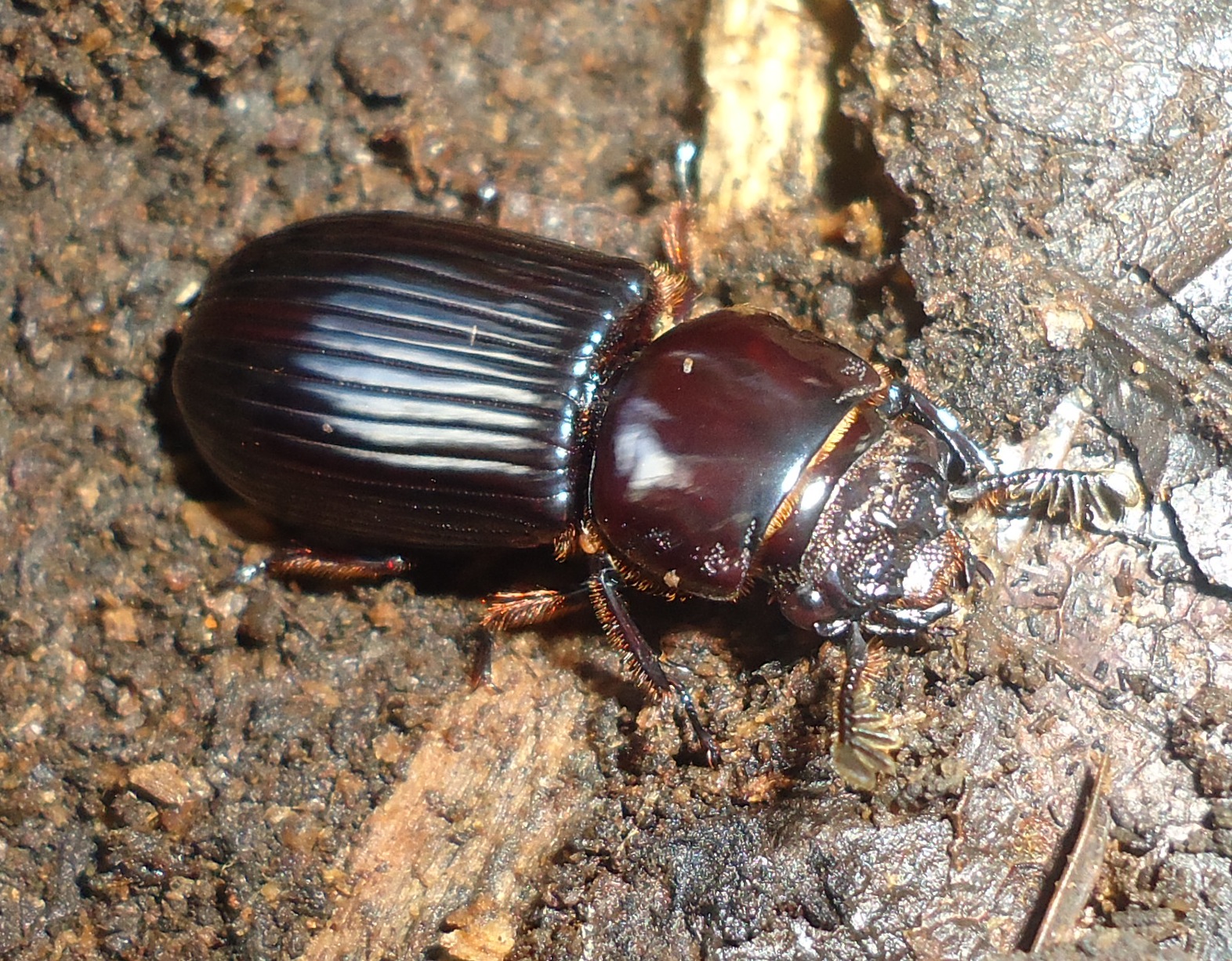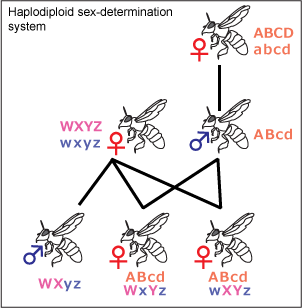|
Augochlora Pura
''Augochlora pura'' is a solitary sweat bee found primarily in the Eastern United States. It is known for its bright green color and its tendency to forage on a variety of plants. Inhabiting rotting logs, this bee can produce up to three generations per year. Both males and females have been observed licking sweat from human skin, most likely seeking salt ''Augochlora pura'' was recently suggested the common name Pure Green Sweat Bee, but about it has been written that "...it does not seem to need one with such a musical scientific designation that means 'pure golden green.'" Taxonomy and phylogeny Within Halictidae, 4 subfamilies, 81 genera, and over 4,000 species have been defined. About 1,000 of the species in the genera ''Halictus'', ''Lasioglossum'', ''Augochlora'', and ''Augochlorella'', are eusocial. Description and identification Both males and females are approximately 8 mm long. Over most of the range of the species, their entire bodies are a shiny, bright gree ... [...More Info...] [...Related Items...] OR: [Wikipedia] [Google] [Baidu] |
Halictidae
Halictidae is the second-largest family of bees (clade Anthophila) with nearly 4,500 species. Halictid species are an extremely diverse group that can vary greatly in appearance. These bees occur all over the world and are found on every continent except Antarctica. Usually dark-colored (frequently brown or black) and often metallic, halictids are found in various sizes, colors and patterns. Several species are all or partly green and a few are red, purple, or blue. A number of them have yellow markings, especially the males, which commonly have yellow faces, a pattern widespread among the various families of bees. The family is one of many with short tongues and is best distinguished by the arcuate (strongly curved) basal vein found on the wing. Females in this family tend to be larger than the males. They are commonly referred to as "sweat bees" (especially the smaller species), as they are often attracted to perspiration. Ecology Most halictids nest in the ground, often in ha ... [...More Info...] [...Related Items...] OR: [Wikipedia] [Google] [Baidu] |
Xylem
Xylem is one of the two types of transport tissue in vascular plants, the other being phloem. The basic function of xylem is to transport water from roots to stems and leaves, but it also transports nutrients. The word ''xylem'' is derived from the Ancient Greek word (''xylon''), meaning "wood"; the best-known xylem tissue is wood, though it is found throughout a plant. The term was introduced by Carl Nägeli in 1858. Structure The most distinctive xylem cells are the long tracheary elements that transport water. Tracheids and vessel elements are distinguished by their shape; vessel elements are shorter, and are connected together into long tubes that are called ''vessels''. Xylem also contains two other type of cells: parenchyma and fibers. Xylem can be found: * in vascular bundles, present in non-woody plants and non-woody parts of woody plants * in secondary xylem, laid down by a meristem called the vascular cambium in woody plants * as part of a stelar arrangement n ... [...More Info...] [...Related Items...] OR: [Wikipedia] [Google] [Baidu] |
Nematode
The nematodes ( or grc-gre, Νηματώδη; la, Nematoda) or roundworms constitute the phylum Nematoda (also called Nemathelminthes), with plant-Parasitism, parasitic nematodes also known as eelworms. They are a diverse animal phylum inhabiting a broad range of environments. Less formally, they are categorized as Helminths, but are taxonomically classified along with Arthropod, arthropods, Tardigrade, tardigrades and other moulting animalia, animals in the clade Ecdysozoa, and unlike platyhelminthe, flatworms, have tubular digestion, digestive systems with openings at both ends. Like tardigrades, they have a reduced number of Hox genes, but their sister phylum Nematomorpha has kept the ancestral protostome Hox genotype, which shows that the reduction has occurred within the nematode phylum. Nematode species can be difficult to distinguish from one another. Consequently, estimates of the number of nematode species described to date vary by author and may change rapidly over ... [...More Info...] [...Related Items...] OR: [Wikipedia] [Google] [Baidu] |
Fusarium
''Fusarium'' is a large genus of filamentous fungi, part of a group often referred to as hyphomycetes, widely distributed in soil and associated with plants. Most species are harmless saprobes, and are relatively abundant members of the soil microbial community. Some species produce mycotoxins in cereal crops that can affect human and animal health if they enter the food chain. The main toxins produced by these ''Fusarium'' species are fumonisins and trichothecenes. Despite most species apparently being harmless (some existing on the skin as commensal members of the skin flora), some ''Fusarium'' species and subspecific groups are among the most important fungal pathogens of plants and animals. The name of ''Fusarium'' comes from Latin ''fusus'', meaning a spindle. Taxonomy The taxonomy of the genus is complex. A number of different schemes have been used, and up to 1,000 species have been identified at times, with approaches varying between wide and narrow concepts of speci ... [...More Info...] [...Related Items...] OR: [Wikipedia] [Google] [Baidu] |
Passalidae
Passalidae is a family of beetles known variously as "bessbugs", "bess beetles", "betsy beetles" or "horned passalus beetles". Nearly all of the 500-odd species are tropical; species found in North America are notable for their size, ranging from 20–43 mm, for having a single "horn" on the head, and for a form of social behavior unusual among beetles. Bodies elongate-cylindrical and black overall; ventral surfaces may be covered with yellow setae. The head is narrower than the thorax, with antennae consisting of 10 antennomeres with a three-segment club. The elytra are elongate with parallel sides, and heavily striated. They are subsocial (brood caring) beetles that live in groups within rotting logs or stumps. The beetles will excavate tunnel systems within rotting wood where the females then lay their eggs. They care for their young by preparing food for them and helping the larvae construct the pupal case. Both adults and larvae must consume adult feces which have b ... [...More Info...] [...Related Items...] OR: [Wikipedia] [Google] [Baidu] |
Lasioglossum Coeruleum
''Lasioglossum coeruleum'' is a species of sweat bee in the family Halictidae. References Further reading * External links * coeruleum Articles created by Qbugbot Insects described in 1893 {{sweat-bee-stub ... [...More Info...] [...Related Items...] OR: [Wikipedia] [Google] [Baidu] |
Circadian Rhythm
A circadian rhythm (), or circadian cycle, is a natural, internal process that regulates the sleep–wake cycle and repeats roughly every 24 hours. It can refer to any process that originates within an organism (i.e., Endogeny (biology), endogenous) and responds to the environment (Entrainment (chronobiology), entrained by the environment). These 24-hour rhythms are driven by a circadian clock, and they have been widely observed in animals, plants, fungi and cyanobacteria. The term ''circadian'' comes from the Latin ''wikt:circa#Latin, circa'', meaning "approximately", and ''dies'', meaning "day". Processes with 24-hour cycles are more generally called diurnal rhythms; diurnal rhythms should not be called circadian rhythms unless they can be confirmed as endogenous, and not environmental. Although circadian rhythms are endogenous, they are adjusted to the local environment by external cues called zeitgebers (German for "time givers"), which include light, temperature and redox cy ... [...More Info...] [...Related Items...] OR: [Wikipedia] [Google] [Baidu] |
Lasioglossum Zephyrum
''Lasioglossum zephyrus'' is a sweat bee of the family Halictidae, found in the U.S. and Canada. It appears in the literature primarily under the misspelling "''zephyrum''". It is considered a primitively eusocial bee (meaning that they do not have a permanent division of labor within colonies),Batra, S. W. T. 1966. The life cycle and behavior of the primitively social bee ''Lasioglossum zephyrum'' (Halictidae). Univ. Kansas Sci. Bull. 46:359–423. although it may be facultatively solitary (i.e., displaying both solitary and eusocial behaviors).Interactions in colonies of primitively social bees: Artificial colonies of ''Lasioglossum zephyrum '. ''PNAS''. Retrieved 08-27-2011. The species nests in burrows in the soil. Taxonomy and phylogeny |
Dufour's Gland
Dufour's gland is an abdominal gland of certain insects, part of the anatomy of the ovipositor or sting apparatus in female members of Apocrita. The diversification of Hymenoptera took place in the Cretaceous and the gland may have developed at about this time (200 million years ago) as it is present in all three groups of Apocrita, the wasps, bees and ants. Structure Dufour’s gland was first described by Léon Jean Marie Dufour in 1841. Along with the spermatheca and the poison gland, it develops as an invagination of valves of the sternum. It empties at the base of the ovipositor in ants but into the dorsal vaginal wall in bees and wasps. The gland is lined by a single layer of epithelial cells which secrete substances into the hollow interior. Muscles round the opening of the duct may help control the outflow. Function The purpose of Dufour’s gland is to secrete chemicals, but the nature of the secretions and their function differs in various hymenopteran groups. The sec ... [...More Info...] [...Related Items...] OR: [Wikipedia] [Google] [Baidu] |
Phloem
Phloem (, ) is the living biological tissue, tissue in vascular plants that transports the soluble organic compounds made during photosynthesis and known as ''photosynthates'', in particular the sugar sucrose, to the rest of the plant. This transport process is called translocation. In trees, the phloem is the innermost layer of the bark (botany), bark, hence the name, derived from the Ancient Greek word (''phloiós''), meaning "bark". The term was introduced by Carl Nägeli in 1858. Structure Phloem tissue consists of conducting Cell (biology), cells, generally called sieve elements, Ground tissue#Parenchyma, parenchyma cells, including both specialized companion cells or albuminous cells and unspecialized cells and supportive cells, such as fibres and sclereids. Conducting cells (sieve elements) Sieve elements are the type of cell that are responsible for transporting sugars throughout the plant. At maturity they lack a Cell nucleus, nucleus and have very few organelles, ... [...More Info...] [...Related Items...] OR: [Wikipedia] [Google] [Baidu] |
Augochlora Pura Nest Under Bark
''Augochlora'' is a genus of sweat bee with over 100 species found across the Nearctic and Neotropic zones. There are at least 110 described species in ''Augochlora''. Nesting Habits and Life Cycle of a Sweat Bee, Augochlora pura. Retrieved 2018-11-09 
See also *List of Augochlora species
This is a list of 118 species in ''Augochlora'', a genus of swea ...
[...More Info...] [...Related Items...] OR: [Wikipedia] [Google] [Baidu] |
Halictus
The genus ''Halictus'' is a large assemblage of bee species in the family Halictidae. The genus is divided into 15 subgenera, some of dubious monophyly, containing over 200 species, primarily in the Northern Hemisphere (a few species occur in South America, Asia and Africa). Most species are black or dark brown, sometimes metallic greenish-tinted, with apical whitish abdominal bands on the terga (the related genus ''Lasioglossum'', which is otherwise often similar in appearance, has the abdominal hair bands located basally, not apically). Many species in the genus are eusocial, with colony sizes range from very small (two to four bees) to large (>200). Nests are typically burrows in the soil, with several ovoid "cells" in which pollen mixed with nectar is provided as food for the developing larvae; a single egg is laid on a pollen mass, and the cell is sealed. In a few species, the cells are arranged in clusters resembling a honeycomb, but constructed of soil rather than beeswax. ... [...More Info...] [...Related Items...] OR: [Wikipedia] [Google] [Baidu] |






